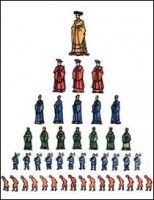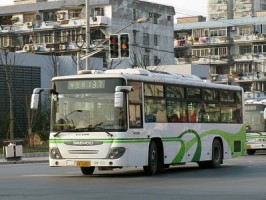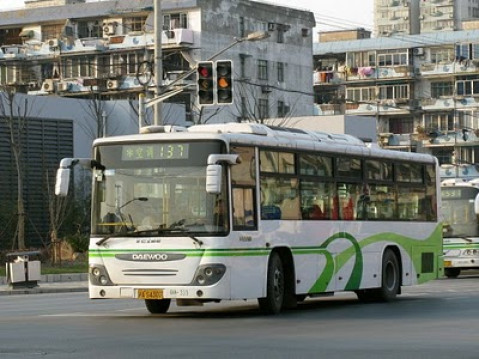Widgetized Section
Go to Admin » Appearance » Widgets » and move Gabfire Widget: Social into that MastheadOverlay zone
From Top-down to Citizen-Driven Community Governance
China’s community service innovation in Xiaojie He District of Chengdu
By Dongquan Li, Renmin University of China and G. Zhiyong Lan, Arizona State University
How does China govern its community? How well has it done? How is it relevant to public service practice to the international community? This essay, by tracing the vicissitudes of China’s community governance, provides a glance into these questions.
 China is typically known by the west as a country with a top-down government that imposes a tight control over its community as well as citizens’ life. This is due perhaps both to its long feudalist tradition and its current regime’s command economy approach. What is often overlooked is the grassroot people’s self-governance in history and the new efforts made by the local government to promote citizen self-governance after its market economy reform. While China still has a long way to go, what is happening now may be a burgeoning effort signaling a new possibility.
China is typically known by the west as a country with a top-down government that imposes a tight control over its community as well as citizens’ life. This is due perhaps both to its long feudalist tradition and its current regime’s command economy approach. What is often overlooked is the grassroot people’s self-governance in history and the new efforts made by the local government to promote citizen self-governance after its market economy reform. While China still has a long way to go, what is happening now may be a burgeoning effort signaling a new possibility.
While after the founding of the Republic of China in 1949, the government has mostly enforced a planned economic policy and enforced central governmental control over state affairs, tight centralization is not necessary the entire picture of China’s governance. Throughout China’s history, local autonomous governance known as township gentleman-governance was more often than not the norm. Throughout the feudal dynasty years, China typically had three to five levels of government: central, provincial and county. Occasionally, between the central and the county, one or two more levels of regional governors were added. Nonetheless, the lowest level of government had always been “the county.”
Each county government was small in size, with an administrator sent by the Imperial Court and a dozen of staff including local police serving at his will. The county usually includes a small town as the county seat and a large rural area. Due to the vast territory and low transportation technology, a majority of the local affairs were actually handled by the local landlords or patriarchal leaders, many of them happened to be retired ranking officials who resettled back in their home town. These local gentry helped create local governance bylaws such as Township Regulations and Villagers Compact, and used them as benchmark behavioral criteria. Sanctions for violation of these bylaws were usually clearly spelled out. This gives us a picture of China’s strong tradition in local self-governance. “Chicken chucks and dog barking could be heard but villagers in neighboring villages had no need to visit with one another until their death” is a well-known saying describing an idealized, tranquil, peaceful, private, and orderly version of its local community life. “No one would pick up a lost item on the road, and there is no need to block the door while sleeping at night” is its pursued objective
After 1949, China stabilized on a five-level government structure: central, provincial, prefectural/municipal, county and township. The township level is the added level stretching further down into the grassroots of the society (in urban areas, known as Jiedao–street level government, and in rural areas, known as rural-township government (at one time this was known as the People’s Commune). The township government does not have tax levy authority but its employees are civil servants and the operation of the township government is fully supported by government revenue. The township government performs grassroot governance/public service function, taking care of the poor, managing social welfare, disposing garbage, implementing urban planning, and ensuring neighborhood safety, organizing community life and providing services. Under its supervision, three major types of communities exist: traditional old living quarters with residents spread out in old type and low-rise street housing (mostly one story); work unit  managed living quarters, a legacy from the planning years during which residents live in residential quarters built and managed by their employers–the governmental agencies, factories or other types of working unit such as universities and hospitals; and commercially developed living quarters, which became popular after the 1978 market reform. Within these commercially developed living quarters, some are purely run and managed by developers and some are sponsored, subsidized, contracted or even managed by the government to host the relocated low income or farmers who lost land in the process of urbanization.
managed living quarters, a legacy from the planning years during which residents live in residential quarters built and managed by their employers–the governmental agencies, factories or other types of working unit such as universities and hospitals; and commercially developed living quarters, which became popular after the 1978 market reform. Within these commercially developed living quarters, some are purely run and managed by developers and some are sponsored, subsidized, contracted or even managed by the government to host the relocated low income or farmers who lost land in the process of urbanization.
Moving into the 21st century, all these communities have started to confront problems. The traditional old living quarters are spread out and hard to manage, urban infrastructure including sewage, toilet, streets, garbage, etc. is poor; residents are either inner city poor or temporary low income renters. Community environment is dirty and safety is hard to ensure.
At the same time, work unit (employer sponsored) living quarters started to deteriorate as many of the units sold the housing units to the dwellers and many dwellers started to move into better quality commercial housing. After a series of housing reform, the work unit no longer shoulders the responsibility of managing and maintaining the living quarters. The third type–the commercially developed units are newer communities. However, often times, the developer-hired community management groups and the homeowners’ associations in these communities fight over interests (profit level versus level of services).
Also, there are communities that are built by the government or government contracted developers for relocated residents from other regions or rural areas. In these, heavy governmental subsidies such as maintenance of the buildings and management of the environment are fully provided by the township government. When the government is short on resources and manpower, which is typically the case, the neighborhood problems started to arise. Neighborhood conflicts, sanitation problems, renovation problems, safety issues such as theft and community parking are constant problems facing these communities. Crime rates were high, complaints were plentiful and residents were full of complaints. The Xiaojia He District in the city of Chengdu was one time in such a situation.
The Xiaojiehe District Township Government is located within the city of Chengdu, China’s fourth largest city which boasts a population of 14 million long-term residents (Nov. 2010 statistics). In its five core urban areas that host 30 percent of the residents, population density averages 10,000 per square kilometers. High population density, inadequate and old city infrastructure, deteriorating local services started to become outstanding problems in many of these areas.
The Xiaojia He Township is located in one of the five core urban areas (2.75 square kilometers with a population of 63,000). It consists of all three types of communities: old urban communities, work unit based communities, newly developed commercial communities, and government built communities for relocated urban and rural dwellers.
Due to the high density and complexity of the composite of the populations, community governance is an awesome undertaking. Quarrels, conflicts and crimes constantly happened. Governmental officials hesitated to pay a visit to these areas because they would most likely be surrounded by residents complaining about the problems related to living in the area. Once in a while, the citizens would take advantage of any possible excuse to demand more subsidies from the government. The tension was high between the residents and the government, quality of life in the neighborhood was poor and citizens were not happy.
Starting in 1998, the Xiaojia He Jiedao District Managers decided that this type of poor community life should not continue. Something needed to be done to give it a lift. The new leader to this district started to implement a local governance structure known as ‘three-in-hand,’ referring to a chariot pulled by three horses at the same time.
Each community establishes a community self-governance group headed by a three member team of leaders. One or more of the team leaders are retired party members or governmental officials. They are asked by local governments to take the lead in volunteering their time to play an active role in local community life. Retirement does not mean entirely retiring. Each time they work–offering service or help with arbitrating a local dispute or call for a citizen meeting to decide on local affairs, they work in groups of three.
The leadership enforcement at the local level has obviously had its payoffs. Many local problems which had existed for a long time got resolved. Unconcerned individuals are now starting to pay attention to community issues. What is most important in this process, as Mr. Xue, the leader of the community, said, “Is to ensure a fair and democratic decision-making process to allow citizens having a say over their own affairs.”
Given strong local leadership, citizen meetings (monthly, weekly or case by case) can actually happen. Citizen voices could be heard, citizens decisions are recorded and implemented and follow ups are monitored by the three member leadership team. Coupled with this local community governance structure, the team also organized citizen forums and a citizen supervisory group overseeing the operation of the three-member leadership team. In addition, the local government uses local revenue to contract with external not for profit organizations to come into the community to help organize citizen groups for cultural activities. The objective is to entice the citizens to manage their own affairs, become responsible and accountable new citizens, and learn that while living in urban communities, a sense of responsibility and the spirit to care for others is of critical importance.
A simple structural reform and a strong commitment to citizen self-governance has carried these residents a long way. Since each community has a team organizing the citizens to take care of their own affairs, environment started to be clean, neighborhood conflicts are quickly resolved, infrastructure issues could get reported in a timely manner, crime rate has been effectively controlled and parking–which has been a big problem due to the increased number of family vehicles and lagging infrastructure improvement has been effectively managed. Now a visit to these communities reveals a clean, orderly and safe space where residents are happy. Citizens feel that they are the masters of their own life and their wishes are respected and their decisions are implemented.
It is most interesting to learn that Mr. Xue, the head of the street level government has spent three months in the United States to learn how communities should be governed. He had exposure to American professors and city managers who place a high value on serving people. When talking with him, he is still full of terms such as democracy, citizen self-governance, community development, citizen capacity building, citizen sense of responsibility, citizen satisfaction and governmental responsibility to serve the people. He noted that his US learning has been an eye-opening experience and he was truly impressed by how US local government officials treat and respect their citizens.
He noted that “Serving the People” is an important Chinese concept. Mao Tsetung, China’s late leader, wrote a household known booklet titled “Serving the People” and this statement is inscribed on a board at the front gate of China’s Central Government Office in Mid-Central Sea in Beijing.
The innovation has definitely happened within the Chinese administrative environment and is full of western flavor. The impact is rewarding both for the government and the people. The government can be hands off and the Chinese urban dwellers are gaining a new personality.
The interesting question for those of us who study public service innovation is whether this should be labeled as a US best practice contribution or a Chinese local innovation? Or perhaps, it does not really matter, “as long as the cat catches the mice.”






Follow Us!